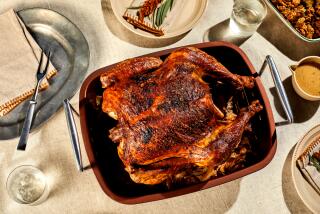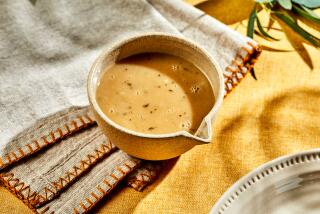Thanksgiving video tips: ‘Deglazing’ 101 and a recipe for turkey gravy
- Share via
When meats or vegetables are sautéed, seared or roasted, they leave behind browned bits stuck to the bottom of the pan. These browned bits can contain an amazing amount of flavor, and are often used to enhance the flavoring of the dish being cooked (say, a ragu, soup or stew) or are later turned into a gravy, glaze or sauce to serve with the finished dish.
Removing that flavoring from the base of a pan and incorporating it into a sauce is called “deglazing.” To deglaze a pan, first remove the cooked meat or vegetables from the pan, along with any extra fat. Add a little liquid to the pan to loosen the browned bits; acids, like wine, are often used, as are broth or water, even fruit juice. Use a wooden spoon or spatula to dislodge the loosened flavorings, then use this flavoring base as desired in the finished dish.
Make sure that the bits stuck to the bottom of the pan are browned and not actually burnt (black and crusty, they will smell bitter and “burnt”), and be aware that it’s harder to get a good deglaze from a nonstick pan (the flavorings won’t really have anything to stick to).
Craving more? Check out our handy holiday recipes and cooking tips page to help you out with your Thanksgiving planning. Not only do we cover familiar holiday dishes, we share tips and tricks to save you time and energy during this busy time of year. And you can find all your Thanksgiving recipe needs in our California Cookbook. If you have any tips or questions you’d like me to explore, leave a comment or shoot me an email at [email protected].
TURKEY GRAVY
Active work time: 20 minutes | Total preparation time: 2 hours, 15 minutes | Makes 2 cups gravy
Note: Giblets may be omitted from gravy, and canned chicken broth may be substituted for homemade broth.
Neck and giblets from 1 turkey
6 cups water
1 onion, quartered
1 carrot, cut in pieces
1 celery stalk, cut in pieces
Black peppercorns
Drippings from roasted turkey
Butter, optional
3 tablespoons flour
1/2 cup whipping cream, optional
Salt, pepper
1. Remove neck and giblets from bird. Separate liver from other giblets and discard or save for another meal. (The liver, the largest and softest of organ meats, clouds the broth.)
2. Place remaining giblets and neck in 2-quart saucepan. Add water, onion, carrot, celery and peppercorns and bring to boil over high heat. Cover, reduce heat to low and simmer until tender, about 1 1/2 hours. Strain and reserve broth. Discard neck. Chop giblets, cover and refrigerate.
3. When turkey is roasted, remove from oven and transfer to platter. Lightly cover with foil and let stand about 20 minutes to allow juices to set before carving.
4. Meanwhile, add 1 cup reserved broth to drippings in roasting pan. Place pan over medium heat and scrape browned particles free from bottom with wooden spoon. Pour mixture into clear measuring cup and let fat rise to top. Skim fat off with spoon, or use specially designed measuring cup that separates the fat.
5. To make 2 cups gravy, place 1/4 cup turkey fat in saucepan. (If necessary, add butter to make 1/4 cup.) Add enough reserved giblet broth to skimmed drippings to make 2 cups.
6. Heat fat over medium heat. Stir in flour and cook, stirring until bubbly. Remove from heat. Gradually pour in dripping-stock mixture, stirring constantly with wire whisk. Return pan to heat, and cook, stirring, until gravy boils and thickens. Add whipping cream, if using, and heat through. For thinner gravy, add more broth. Stir in giblets. Season to taste with salt and pepper.
Each tablespoon: 20 calories; 67 mg. sodium; 3 mg. cholesterol; 1 gram fat; 1 gram carbohydrates; 1 gram protein; 0.05 gram fiber.
Love cooking as much as I do? Follow me @noellecarter
More to Read
Eat your way across L.A.
Get our weekly Tasting Notes newsletter for reviews, news and more.
You may occasionally receive promotional content from the Los Angeles Times.











